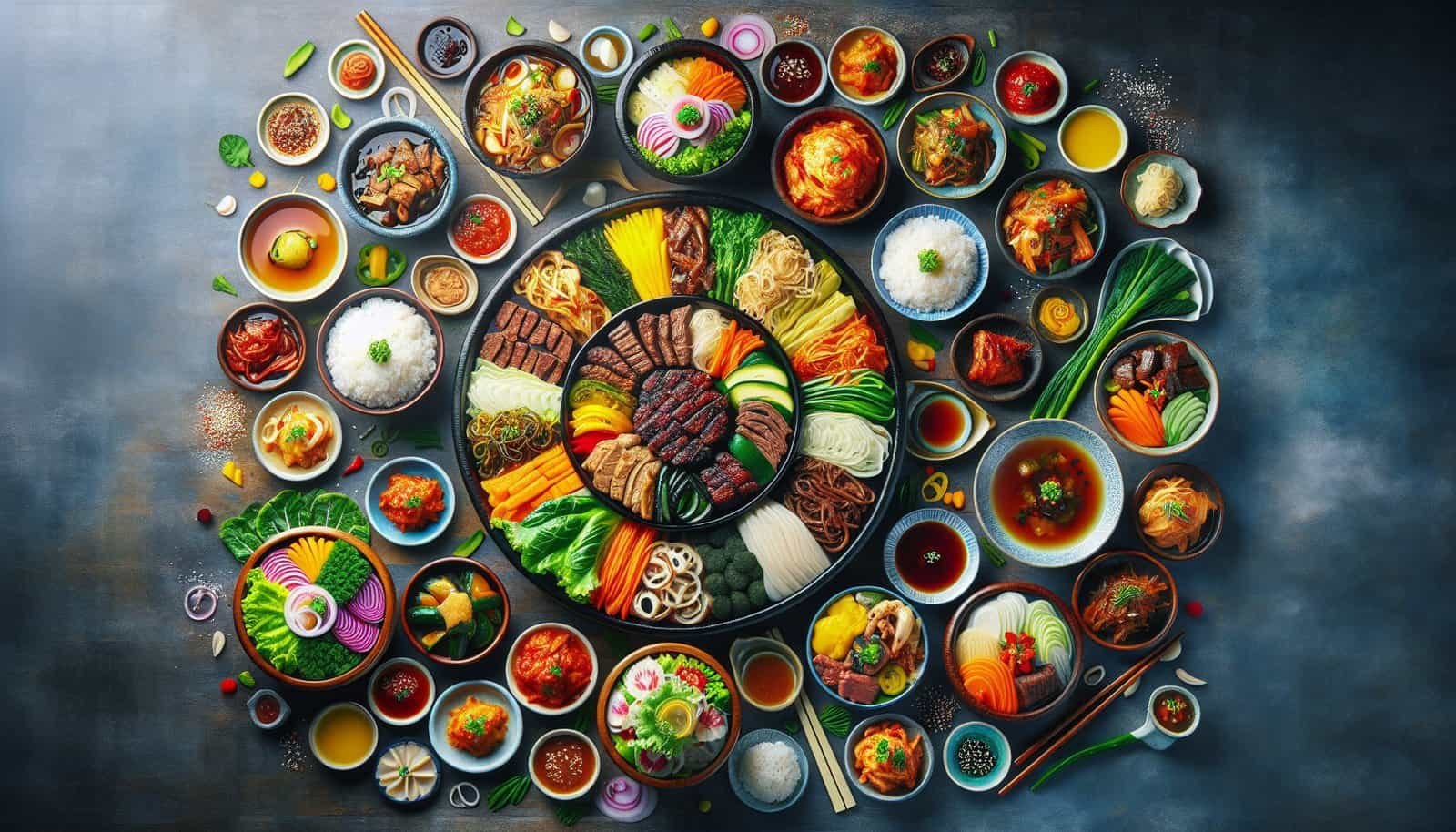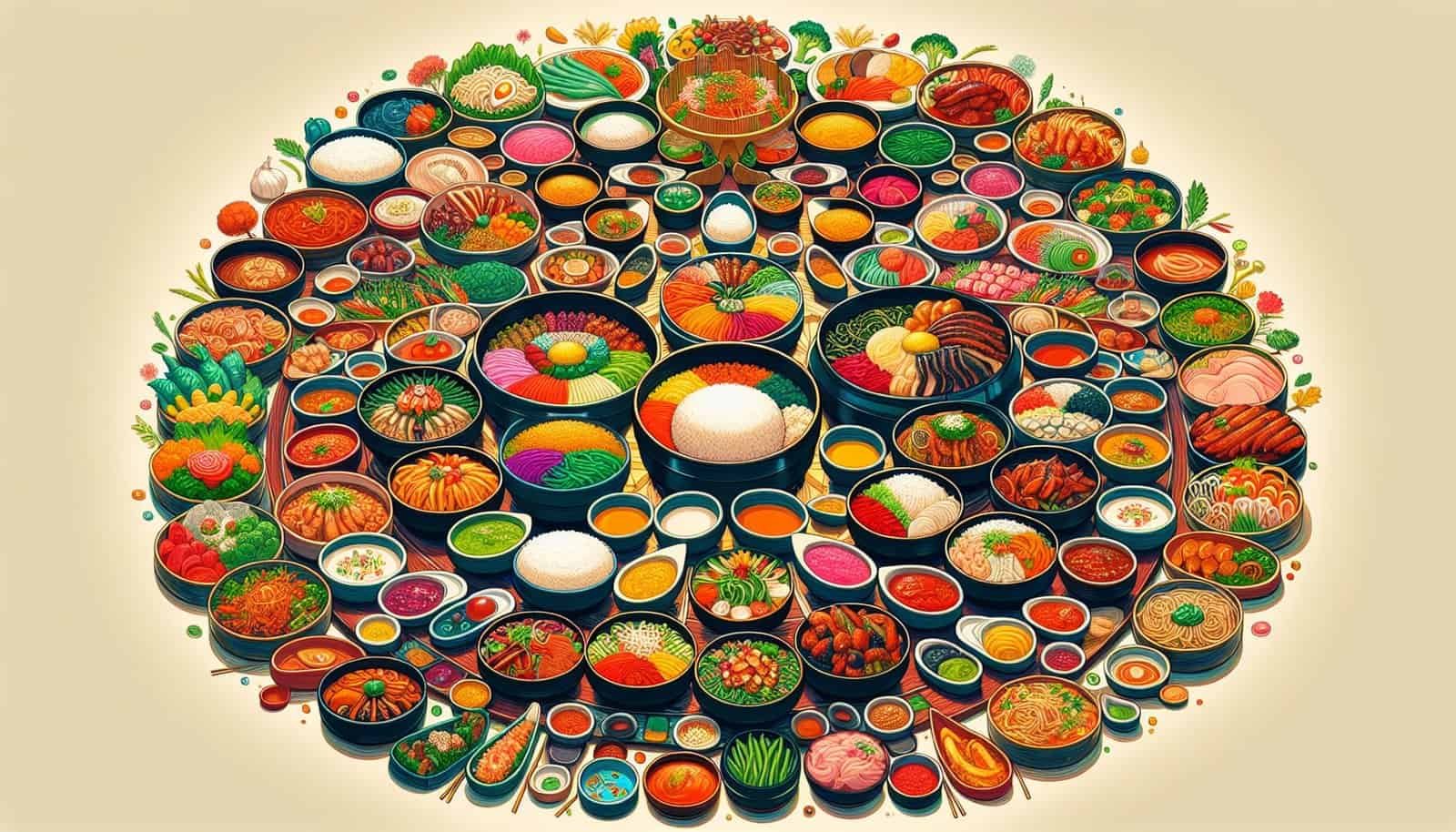Are you curious about the recent surge in fascination with regional Korean cuisines? From the fiery flavors of Seoul to the delicate and subtle tastes of Jeju Island, Korean cuisine has been garnering attention worldwide. With the increasing popularity of Korean dramas, K-pop, and the growing influence of Korean culture, people are eager to explore the rich diversity of Korean food. So, what is driving this growing interest in regional Korean cuisines? Let’s dig deeper into the flavors, techniques, and stories behind these mouthwatering dishes to uncover the secret behind their appeal.

Regional Korean Cuisines
Introduction to regional Korean cuisines
Korean cuisine is renowned for its bold flavors, vibrant colors, and the diverse range of dishes it offers. One aspect that sets Korean cuisine apart is its rich regional diversity. Each region within South Korea and North Korea boasts its own unique culinary traditions, ingredients, and flavors. From the bustling streets of Seoul to the serene countryside of Gyeongsang Province, regional Korean cuisines have captivated the taste buds of locals and foreigners alike.
Historical significance of regional Korean cuisines
The roots of regional Korean cuisines can be traced back thousands of years. Korean cuisine has been shaped by various historical and cultural influences, including the trade routes that connected Korea to neighboring countries like China and Japan. The regional differences in cuisine were greatly influenced by the geography and climate of each region, as well as the availability of local ingredients. Over time, these distinct regional cuisines developed and became an integral part of Korean culture and identity.
Diverse regional cuisines in South Korea
South Korea, known for its bustling cities and picturesque landscapes, boasts a diverse range of regional cuisines. From the spicy and bold flavors of the Gyeongsang region to the mild and delicate tastes of the Jeolla region, there is something to satisfy every palate. The Gyeongsang region is famous for its hearty soups and stews, while the Jeolla region is renowned for its seafood dishes and vegetable-based meals. Each region in South Korea offers a unique culinary experience, showcasing the richness and diversity of Korean cuisine.
Prominence of regional cuisines in North Korea
Though less accessible to the outside world, North Korea also has its own distinct regional cuisines. Similar to South Korea, North Korea has regional variations in its culinary traditions. The cuisine of Pyongyang, the capital city, is known for its refined flavors and elaborate presentation, while the cuisine of Hamgyong Province in the northeast is characterized by its hearty, meat-based dishes. Despite the political barriers that restrict the flow of information, regional Korean cuisines in North Korea continue to evolve and thrive.
Factors Driving the Growing Interest
Korean wave and cultural influence
The global phenomenon known as the Korean wave, or Hallyu, has played a significant role in increasing the popularity and interest in regional Korean cuisines. Korean entertainment and pop culture, including K-dramas and K-pop music, have gained immense popularity worldwide. As people become more exposed to Korean culture through these mediums, their curiosity about Korean cuisine naturally grows, leading to a greater demand for authentic regional dishes.
Increasing globalization and international travel
In today’s interconnected world, people from different cultures are constantly interacting and exploring new cuisines. This has led to an increase in international travel, allowing individuals to experience firsthand the diverse flavors of regional Korean cuisines. As travelers immerse themselves in the local food scene, they develop a deeper appreciation for the distinctiveness of regional Korean dishes, further fueling the interest in these culinary traditions.
Food tourism and culinary exploration
The rise of food tourism has also contributed to the growing interest in regional Korean cuisines. Food enthusiasts and travelers are now actively seeking out authentic culinary experiences during their trips. From participating in cooking classes to visiting local markets and street food stalls, these experiences allow individuals to delve into the intricacies of regional Korean cuisines and gain a deeper understanding of the cultural significance behind each dish.
Rise of social media and digital food culture
In the age of social media, food has become a popular subject of discussion and exploration. Platforms like Instagram and YouTube have provided a new way for individuals to share their culinary discoveries and experiences. Food bloggers and influencers have played a pivotal role in showcasing regional Korean cuisines to a global audience, generating hype and curiosity amongst their followers. The digital food culture has made it easier than ever for individuals to discover and learn about regional Korean dishes, attracting even more interest in these unique culinary traditions.
Distinct Characteristics of Regional Korean Cuisines
Geographical influence on regional cuisines
The geography of each region in Korea heavily influences its culinary traditions. The coastal regions, such as Jeolla and Gangwon, have a strong emphasis on seafood, while the mountainous regions, like Gyeonggi and Gyeongsang, rely more heavily on land-based ingredients. The availability of different ingredients, such as fish, vegetables, and various meats, has shaped the flavor profiles and cooking techniques of each region’s cuisine.
Ingredients and flavors unique to each region
Regional Korean cuisines are characterized by the use of distinct local ingredients and flavors. For example, Jeju Island is famous for its black pork, which is known for its tender texture and rich flavor. The Gyeongsang region is renowned for its spicy and bold dishes, often made with red chili peppers and garlic. Each region takes pride in utilizing local produce and specialty ingredients to create the authentic flavors that define their culinary traditions.
Cooking methods and traditional techniques
The cooking methods and techniques used in regional Korean cuisines also contribute to their distinct characteristics. Fermentation plays a significant role in many traditional dishes, such as kimchi and doenjang (soybean paste). The use of various pickling techniques, such as jangajji (pickled vegetables), adds complexity and depth to the flavors. Traditional cooking methods, such as grilling over hot coals or boiling in a hot pot, are passed down through generations, preserving the authentic taste and texture of regional Korean dishes.
Influences from neighboring countries
Korea’s geographic location has exposed its cuisine to influences from neighboring countries, particularly China and Japan. This has resulted in unique fusion dishes and flavors in some regions. For example, the cuisine of the Gyeongsang region shows influences from China, with dishes like jajangmyeon (noodles with black bean sauce) and tangsuyuk (sweet and sour pork) making their mark. The influence of Japan can be seen in the coastal regions, where dishes like sushi and sashimi have been adapted to incorporate local Korean ingredients and flavors.
Popular Regional Korean Dishes
Jeonju Bibimbap: Iconic dish from Jeolla Province
One of the most famous regional dishes in Korea is Jeonju bibimbap, which originated from the Jeolla Province. Bibimbap, meaning “mixed rice,” consists of a bowl of warm rice topped with an assortment of vegetables, meat, and a fried egg. It is typically served with gochujang (red chili pepper paste) and mixed together before eating. Jeonju bibimbap is known for its vibrant colors and harmonious combination of flavors, making it a must-try dish for visitors to the region.
Andong Jjimdak: Spicy braised chicken from Andong
Andong jjimdak is a popular dish hailing from the city of Andong in Gyeongsang Province. It is a spicy braised chicken dish made with soy sauce, vegetables, and various spices. The chicken is simmered slowly to absorb the flavors, resulting in tender and succulent meat. The dish is often enjoyed with a side of noodles or rice cakes, adding another layer of texture and taste. Andong jjimdak has gained widespread popularity, becoming a representative dish of the region.
Jeju Black Pork: Specialty of Jeju Island
Jeju Island, a picturesque island in South Korea, is known for its unique black pork. The black pig is a breed indigenous to the island, and its meat is highly prized for its tenderness and rich flavor. Jeju black pork is often enjoyed grilled, allowing the natural flavors of the meat to shine. The island’s clean air, natural environment, and special diet contribute to the distinct taste of the pork, making it a delicacy sought after by locals and tourists alike.
Gangwon Buckwheat Noodles: Refreshing cold noodles
Gangwon Province, located in the northeastern part of South Korea, is famous for its buckwheat noodles, also known as memil guksu. These noodles are made from buckwheat flour and are enjoyed cold, especially during the hot summer months. The noodles are served in a chilled broth with various toppings, such as sliced cucumber and pickled radish. The refreshing and nutty flavors of the buckwheat noodles make them a popular choice for locals and tourists looking for a light and flavorful meal.
North Korean Naengmyeon: Cold noodles with unique toppings
North Korean naengmyeon, or cold noodles, is a specialty dish from the northern regions. It is typically made with buckwheat noodles served in a cold, tangy broth. The noodles are topped with various ingredients, such as sliced radish, cucumber, and boiled eggs. The unique toppings and the slightly sweet and tangy broth give North Korean naengmyeon its distinctive flavor profile. Despite its name, this dish can be found in both North and South Korea, each with its own regional variations.

Regional Cuisines and Health Benefits
Nutritional advantages of regional Korean cuisines
Regional Korean cuisines are known for their health benefits, as they incorporate a wide range of fresh and nutritious ingredients. Many dishes are packed with vegetables, which provide essential vitamins and minerals. Seafood dishes, common in coastal regions, are rich in omega-3 fatty acids and protein. Regional cuisines also make use of a variety of protein sources, including lean meats and tofu. The emphasis on balanced meals and the diversity of ingredients contribute to the overall nutritional value of regional Korean dishes.
Dietary diversity and balanced eating patterns
Regional Korean cuisines promote dietary diversity and balanced eating patterns. The inclusion of various food groups, such as grains, vegetables, proteins, and fermented foods, ensures a well-rounded meal. The emphasis on whole foods and minimal processing further enhances the nutritional value of the dishes. Regional cuisines also encourage portion control, as meals are traditionally served in multiple small plates. This balanced and varied approach to eating contributes to the overall health benefits of regional Korean cuisines.
Fermented foods and their probiotic benefits
Fermentation is a key element in Korean cuisine, particularly in regional dishes like kimchi and doenjang. These fermented foods are rich in probiotics, which promote a healthy gut microbiome. Probiotics have been linked to numerous health benefits, including improved digestion, strengthened immune system, and enhanced mental health. The consumption of fermented foods in regional Korean cuisines adds another layer of health benefits, making them a valuable component of a nutritious diet.
Regional ingredients and their medicinal properties
Many regional Korean cuisines incorporate ingredients that are known for their medicinal properties. For instance, ginseng is often used in dishes from the Gangwon region, as it is believed to boost energy and improve overall health. Daegwallyeong Samgyeopsal, a pork dish from the same region, uses pork from pigs fed with medicinal herbs, further enhancing its health benefits. Regional Korean cuisines leverage the natural goodness of local ingredients to promote not only delicious flavors but also overall well-being.
Preservation and Promotion Efforts
Government support for regional cuisines
The Korean government recognizes the cultural and economic value of regional Korean cuisines and has implemented various initiatives to support their preservation and promotion. This includes funding research efforts, providing financial support to regional culinary associations, and organizing culinary events and exhibitions. By investing in the preservation and promotion of these culinary traditions, the government aims to maintain the unique identity of each region’s cuisines and ensure their continued recognition both domestically and internationally.
Establishment of culinary centers and academies
To educate the younger generation on regional Korean cuisines, culinary centers and academies have been established in various regions. These institutions offer courses and workshops on traditional cooking techniques, regional ingredients, and the history behind each dish. By equipping aspiring chefs and food enthusiasts with the knowledge and skills required to prepare regional Korean dishes, these centers and academies play a vital role in preserving the authenticity and promoting the heritage of these culinary traditions.
Integration of regional cuisines in tourism strategies
Regional Korean cuisines have become an integral part of South Korea’s tourism strategy. Local governments and tourism boards actively promote the unique culinary experiences that each region has to offer. This includes organizing food tours, creating food trails, and showcasing regional dishes in food festivals and events. By highlighting the regional cuisines as tourist attractions, South Korea aims to draw in visitors who seek to explore and indulge in the authentic flavors of the country.
Culinary competitions and festivals
Culinary competitions and festivals have become avenues for showcasing regional Korean cuisines. These events provide platforms for local chefs and home cooks to demonstrate their skills and creativity in preparing regional dishes. They also attract a wide audience, including tourists and food enthusiasts, who have the opportunity to taste and learn about the diverse range of regional Korean cuisines. These culinary competitions and festivals not only celebrate the culinary traditions of each region but also contribute to their preservation and promotion.

Challenges in Preserving Authenticity
Industrialization and mass production
One of the challenges in preserving the authenticity of regional Korean cuisines is the impact of industrialization and mass production. As the demand for Korean cuisine grows, the food industry has embraced mass production techniques to meet the needs of a larger consumer base. While this allows for greater accessibility to regional dishes, it also poses a risk to the unique flavors and traditional cooking methods that define each region’s cuisine. The challenge lies in finding a balance between mass production and preserving the authenticity of regional Korean cuisines.
Standardization of flavors and commercialization
Commercialization and the desire for consistent flavors can pose a threat to the diversity of regional Korean cuisines. To appeal to a broader audience, flavors may be standardized and modified to cater to popular taste preferences. This can lead to a loss of the distinct characteristics and traditional techniques that define each region’s cuisine. Preserving the authenticity of regional Korean cuisines requires a conscious effort to maintain the unique flavors while still allowing for innovation and adaptation to meet modern demands.
Threat of losing traditional recipes and techniques
As traditional recipes and techniques are passed down through generations, there is a risk of losing these valuable culinary traditions. Younger generations may be less interested in learning the intricacies of regional Korean cuisines, opting for more convenient and modern cooking methods. With the decline in the number of individuals who possess the knowledge and skills required for traditional dishes, the risk of losing these authentic recipes and techniques becomes imminent. Efforts must be made to document and pass on these traditional practices to future generations.
Maintaining authenticity in fusion and modern interpretations
With the rise of fusion cuisine and modern interpretations, there is a challenge in maintaining the authenticity of regional Korean cuisines. While incorporating new ingredients and techniques can lead to exciting and innovative dishes, it is essential to strike a balance between preserving the traditional flavors and introducing new elements. The challenge lies in ensuring that fusion and modern interpretations pay respect to the cultural heritage and distinctive characteristics of each region’s cuisine, while still offering unique and novel culinary experiences.
Future Outlook and Opportunities
Continued growth of Korean wave and cultural exports
The Korean wave shows no signs of slowing down, and this continued global interest in Korean culture will undoubtedly create further opportunities for the promotion and appreciation of regional Korean cuisines. As Korean entertainment and pop culture continue to capture the international market, more individuals will be exposed to the rich culinary traditions of Korea, igniting their curiosity and desire to explore regional Korean dishes.
Expanding global awareness and appreciation
With the increasing globalization and ease of access to information, individuals around the world are becoming more aware of regional cuisines and seeking out new culinary experiences. This presents an opportunity for regional Korean cuisines to gain wider recognition and appreciation. As individuals develop a deeper understanding of the cultural significance behind each dish and the flavors unique to each region, the demand for authentic regional Korean cuisines will continue to grow.
Culinary collaborations and cultural exchanges
The culinary world thrives on collaborations and cultural exchanges, and regional Korean cuisines have the potential to play a significant role in these interactions. Chefs from different countries can collaborate with Korean chefs to create unique fusion dishes that showcase the flavors of both regions. Culinary exchanges, where chefs travel to different countries to share their expertise, can also promote the understanding and appreciation of regional Korean cuisines on a global scale.
Integration of regional Korean cuisines in fine dining
As regional Korean cuisines gain recognition and appreciation, there is an opportunity for their integration into the fine dining scene. Fine dining establishments can showcase regional Korean dishes in innovative and refined ways, elevating them to new levels of sophistication. By highlighting the unique flavors and culinary traditions of each region, fine dining can act as a platform for regional Korean cuisines to be celebrated as part of the global culinary landscape.

Conclusion
The growing interest in regional Korean cuisines is a testament to the richness and diversity of Korean culinary traditions. From the vibrant colors of Jeonju bibimbap to the bold and spicy flavors of Andong jjimdak, each region in South Korea and North Korea offers a unique culinary experience that captivates the taste buds and showcases the cultural heritage of the country. However, the preservation and promotion of these regional cuisines come with their challenges, including the need to balance mass production and authenticity, and the risk of losing traditional recipes and techniques.
Despite these challenges, the future outlook for regional Korean cuisines is promising. The continued growth of the Korean wave, increasing global awareness and appreciation, culinary collaborations, and the integration of regional Korean cuisines in fine dining present exciting opportunities for these culinary traditions to thrive. By preserving the unique characteristics and flavors of each region’s cuisine, regional Korean cuisines will continue to be a source of pride and celebration, offering individuals from all over the world the opportunity to explore and experience the authentic tastes of Korea.
